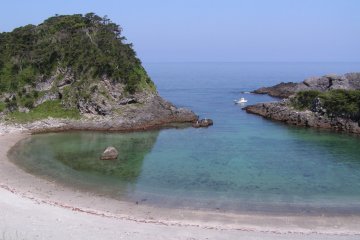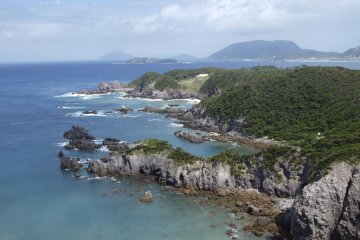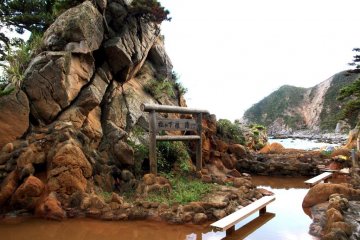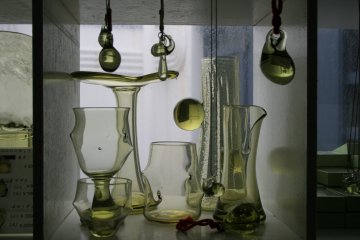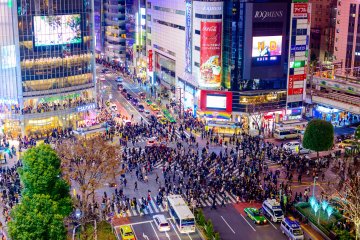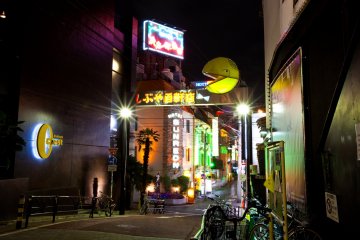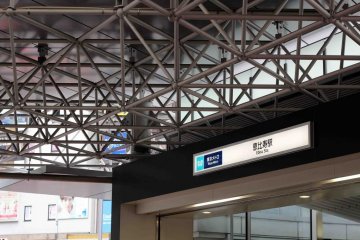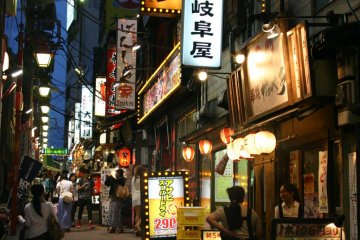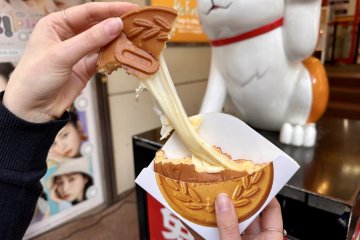To many, Tokyo is defined by its skyline—a never ending sea of highrise buildings, neon lights, and bustling streets.
In reality however, the metropolis is far more than these stereotypical city traits and encompasses an array of tiny islands that span a distance of approximately 110 to 1,000 km south of central Tokyo, with most being easily accessible from the mainland. Nestled in the Pacific Ocean, these islands are renowned for their unspoilt beauty, delicious regional cuisines, and slew of outdoor activities.
Shikinejima, approximately 160 km south of central Tokyo, is a 12 km round island popular for its pristine beaches, rocky coves, hot springs, fresh seafood, and turquoise waters—making it an authentic Japanese island getaway. Thanks to Shikinejima’s small size, most of its destinations are easily accessible by foot or bike.
Join us on a journey of this remarkable island and discover a unique side of Tokyo!
Day One

We started our journey at 9am with a high-speed jet ferry ride from Tokyo’s Takeshiba Terminal. After about three hours of smooth sailing, we reached our destination—Shikinejima! Brilliant waters juxtaposed against verdant hillsides greeted us, and the fresh ocean breeze filled our chests with a yearning for adventure. First stop—lunch!
Ikemura Shoten

Ikemura Shoten, located about five minutes by car ride from Nobushi port, is a popular bakery that sells freshly baked bread and homemade lunches (bento) crafted with local produce. Aside from its handmade offerings, the store also sells beverages, instant ramen, sweet and savory snacks, and even beach supplies.
After perusing the enticing meals, we chose the store’s most popular lunch item, the isonori bento. In Japanese, isonori refers to seaweed that grows naturally on a rocky shore. The bento was reasonably priced at 620 yen and featured island ingredients such as locally made nori, ashitaba tempura—a leafy green indigenous to the Izu Islands, and locally caught fish tempura. The savory flavors deliciously reflected the sea without being overpowering, and the dish’s multiple components of rice, tempura, and nori created a nice balance of textures.

Ashijiyama Observatory

After enjoying the flavors of the sea at Ikemura Shoten, we drove about five minutes to our next destination, Ashijiyama Observatory, situated on the southern end of the island. The trail to the lookout point is located off the side of a road—about a 2-minute walk from the nearby parking lot—and is about a five-minute walk to the summit.
From the top, we were treated to expansive panoramas of the Pacific Ocean and could even see the distant forms of Tokyo's other islands—Niijima, Miyakejima, and Kozushima. Here, deep blue waters sparkled with the shifting tide, and frothy white waters mimicked the clouds as gradients of blue met at the horizon. The melody of the waves, coupled with the refreshing breeze, completed the mesmerizing scene.
Toyoji Temple

Next, we drove to Toyoji Temple. Toyoji is the only temple located on Shikinejima and is home to a 900-year old inumaki tree, a natural monument of Tokyo.
After admiring the inumaki tree, which exuded longevity with its massive trunk and weathered bark, we climbed a short stone staircase to the main temple grounds. The temple’s simple design and natural tones sat in perfect harmony with the surrounding naturescape, and the gentle sounds of birds, wind chimes, and rustling bamboo leaves made the area a picture of serenity. The temple’s priest—a kind, motorcycle-riding islander—invited us inside the temple, which was decorated in vibrant red detailing and golden artifacts, and briefly spoke to us about Buddhism. Before leaving, he gave us each a fortune.
Jinata Onsen

Jinata Onsen, a roughly five-minute drive from Toyoji Temple, is an open-air hot spring located on Shikinejima’s southern coast and one of the island’s most popular attractions. Aside from the brownish tint of the water, the onsen is indistinguishable from the surrounding ocean. The water’s temperature varies depending on the fluctuating tide as it changes the ratio of ocean water to hot spring water. The onsen is free to enter, but please note that bathing suits are required.
When we visited the onsen in the evening, the water’s temperature was perfect. With the slight smell of sulfur on the breeze, we submerged ourselves in the enriching waters and felt our daily worries wash away with the sea. Each time a wave crashed nearby, a refreshing rush of cool seawater mingled with the hot spring. The area truly epitomized tranquility.
Hidabun

Hidabun, situated on the southeastern side of the island, is a guest house with dormitory-style rooms, private rooms, shared bathrooms, a dining area, a BBQ area, and meal plans. The meals, which include breakfast and dinner, vary daily depending on the catches of the day. The facility is only a two-minute walk from the coast and welcomes guests with a homey atmosphere that reflects the close-knit vibes of the island.
Since we chose an accommodation plan with meals, Hidabun served us a lovely dinner of shima ryouri, or local island cuisine. The meal included grilled fish caught that very day, salad, pickles, tempura, rice, and sashimi. The freshness and attention to detail were phenomenal.
Day Two
Snorkeling at Kanbiki Bay

After a refreshing rest at Hidabun, we started our morning with a snorkeling experience at Kanbiki Bay! Thanks to its emerald waters, encircling cliffs, and gentle tide, the bay is known as one of the most beautiful parts of the island. The snorkeling tour is hosted by Shikinejima KaishinMaru, a local business, and departs from Shikinejima port on the southeastern coast of the island.
After meeting at the port, we piled into our guide’s boat and started our journey to the snorkeling spot. The approximately 20-minute boat ride was filled with captivating oceanside views, and before we knew it, we had reached our destination. Eager to explore the wonders of the sea, we quickly donned life vests and snorkeling attire and jumped into the ocean. The crystal water provided excellent visibility, and we witnessed a variety of fish swimming against the coral adorned sea floor. As we explored the area, multiple fuedai (spotted snappers) followed us around, intrigued by our presence. Thanks to the life vests, the two-hour experience was invigorating, rather than exhausting. The natural beauty above and below the water made snorkeling at Kanbiki Bay a truly mesmerizing experience.
Matsugashita Miyabiyu and Ashitsuki Onsens

Situated near Shikinejima port, Matsugashita Miyabiyu and Ashitsuki Onsens are cherished hot spring spots that have been enjoyed by islanders for years. Resting along the sea, the adjacent facilities are open 24-hours a day and feature baths with both brown-tinged and transparent water. Similar to Jinata Onsen, the onsens are free to enter and require visitors to wear bathing suits. From the rejuvenating waters, which are known to have healing properties, guests can enjoy unobstructed views of the ocean against Shikinejima’s rocky coastline. For us, the warm waters were a perfect place to unwind after hours of snorkeling.

NINZ Coffee

After relaxing at Ashitsuki Onsen, it was time for us to recharge over lunch! NINZ Coffee, located on the island’s eastern side, is a small cafe that not only sells drinks and meals, but also offers snorkeling and scuba diving experiences. The drink prices range from 400 to 600 yen and meals range from 800 to 1100 yen. With options such as coffee, smoothies, spicy chicken curry, and more, the cafe is a popular place to grab a bite to eat.
After careful consideration, I ordered omurice and a cream soda. Omurice is a delicious Western-Japanese fusion dish that features ketchup-flavored fried rice topped with a fluffy omelet and a sweet and savory ketchup-based sauce, and Japanese cream soda is a luscious combination of melon soda and vanilla ice cream. The meal’s variety of flavors, textures, and temperatures created a wonderfully satisfying meal.
Kanbiki Observatory

Located towards the western side of Shikinejima, Kanbiki Observatory is a stunning lookout point that offers views of the Izu Peninsula, Toshima, Niijima, Kozushima, and even Mount Fuji on clear days! From the parking lot, the observation point is about a five-minute walk up a stone staircase along the hillside.
From the vantage point, we were treated to captivating views of Shikinejima’s verdant coastline. Due to the elevation, the waves sounded distant, making the observatory a quiet and peaceful spot to enjoy the majestic landscape.
Sunset at Oura Beach

We ended our day with a sunset view at Oura beach. Located on the island’s northern coast, the area is known as one of the best places to watch the sunset on Shikinejima and features a seating area where visitors can rest and enjoy the natural spectacle. The beach is also home to a unique rock formation that resembles a horse drinking water.
As the sun dipped towards the horizon, the landscape took on an ethereal appearance. Golden sunlight glittered on the dancing tide, and the sky’s coloring shifted from blue to yellow. The vibrant ocean lost its hue and transitioned into an inky, transparent tide as the beach’s encircling cliffs became simple silhouettes against the sky. During the final stages of the sunset, soft streaks of pink stretched across the deepening sky, until finally the moon took its place among the clouds.

Day Three
Tomari Beach

For our last day on Shikinejima, we started our morning with a trip to the beach! Tomari beach, located near the northern part of the island, is one of Shikinejima’s most popular beaches and is characterized by its transparent, turquoise waters, white sand, and encircling cove. The shallow waters are usually calm, making the beach a relaxing place for visitors to swim, snorkel, or simply float with the tide.
Tomari Shrine

Tomari Shrine is a quaint structure located only five minutes by foot from Tomari beach, making it a perfect accompanying destination. The shrine’s entrance is marked by a large white torii on the side of the road and is surrounded by verdant nature.
After following a short earthen path, we reached the main shrine grounds. Here, another white torii, along with two guardian statues, stood at the entrance of the main hall. The nature-worn structure seemed to blend into the scenery, and aside from the faint bug noises emanating from the trees, the area was quiet, creating a peaceful atmosphere. The introspective environment was a wonderful place to end our island adventure.
Until Next Time, Shikinejima
Although small in size, Shikinejima has no shortage of natural beauty and local charm, making it a wonderful place for visitors to experience hidden, yet equally rich, sides of Tokyo.
While recounting our island adventures, we remembered the fortunes Toyoji’s priest gave us. Roughly translated, mine read, “Calm words make people’s hearts gentle.” Through its ever-present natural beauty, ocean-crafted symphonies, nourishing cuisines, and welcoming island community, Shikinejima embodied the essence of “calm words” and left us feeling refreshed and lighter as we headed back to the mainland.
Visit Shikinejima, and Discover its Beauty for Yourself

You can access Shikinejima by a high-speed jet ferry or large passenger ship operated by Tokai Kisen Co. from Tokyo Takeshiba Pier or take a plane from Chofu airport to Niijima, and then catch a ferry or ship to the island. Listed below are the approximate travel times as of September 2022. View more details on ferry pricing and times.
- Tokyo to Shikinejima (high-speed jet ferry): about 3 hours
- Tokyo to Shikinejima (large passenger ship): 9-11 hours (depending on the time of year)
- Tokyo to Shikinejima (plane): 40-minute plane ride & 10-minute ferry ride
For ferry rides, you can book your tickets online or via phone / through a Travel Agency. From Tokyo, the departure point is located at Takeshiba Terminal, which is about a one-minute walk from Takeshiba Station on the Yurikamome Line, a 15-minute walk from JR Hamamatsucho Station, and a 10-minute walk from Daimon Station.
Shikinejima is waiting for you!
Veronica Carnevale @veronica.carnevale
Fulfilling my traveler's soul!




